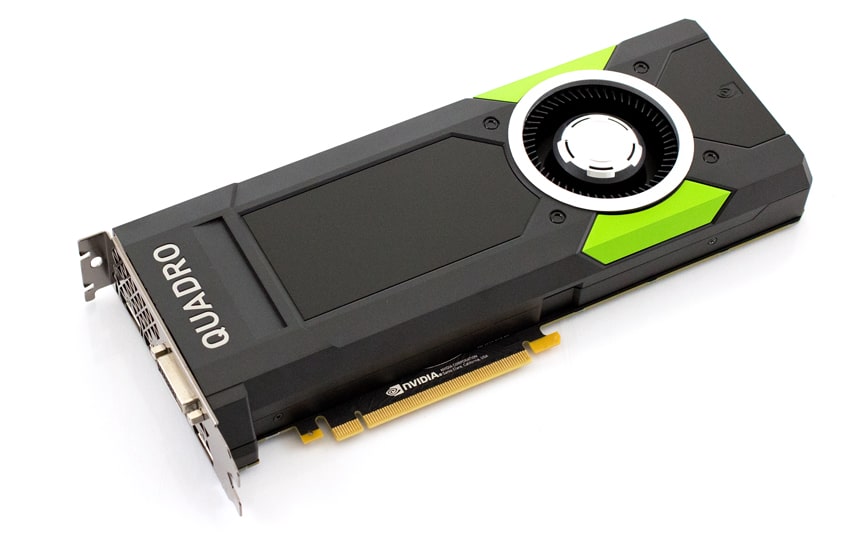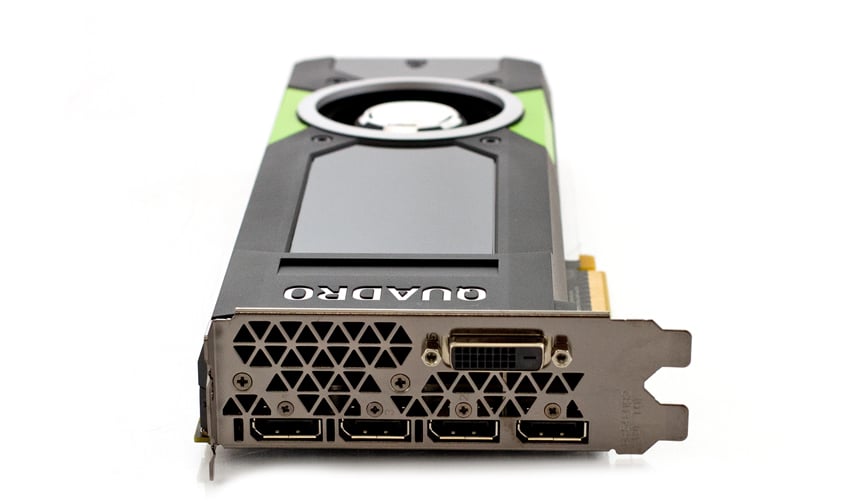 We previously reviewed several of the lower to mid-range cards from NVIDIA’s new Quadro line, and now we’re moving into higher end models, specifically the P5000. This powerful card is equipped with more CUDA cores and larger frame-buffers compared to the lower models, enabling significantly better performance during larger datasets in complex enterprise workflows. Additionally, NVIDIA indicates that its advanced GPU-accelerated ray tracing technologies, such as NVIDIA Iray, allow professionals to complete their projects much faster.
We previously reviewed several of the lower to mid-range cards from NVIDIA’s new Quadro line, and now we’re moving into higher end models, specifically the P5000. This powerful card is equipped with more CUDA cores and larger frame-buffers compared to the lower models, enabling significantly better performance during larger datasets in complex enterprise workflows. Additionally, NVIDIA indicates that its advanced GPU-accelerated ray tracing technologies, such as NVIDIA Iray, allow professionals to complete their projects much faster.
We previously reviewed several of the lower to mid-range cards from NVIDIA’s new Quadro line, and now we’re moving into higher end models, specifically the P5000. This powerful card is equipped with more CUDA cores and larger frame-buffers compared to the lower models, enabling significantly better performance during larger datasets in complex enterprise workflows. Additionally, NVIDIA indicates that its advanced GPU-accelerated ray tracing technologies, such as NVIDIA Iray, allow professionals to complete their projects much faster.

The Pascal-powered P5000 was built using a 16nm FinFET+ manufacturing process to allow for more transistors, operation in higher frequencies, and better overall performance per watt. It comes with a generous 16GB of the new GDDR5X memory, one of the first professional graphics cards to use this type memory (which supports up to 9Gbps). The P5000 also supports the new Quadro Sync II add-in card, allowing users the ability upwards of 32 displays from a single computer.

The Quadro P5000 measures 4.4” in height and 10.5” in length, and uses a dual slot via the PCI Express 3.0 x16 interface. It features the usual 4x 1.2 DisplayPorts as well as 1x DVI-I and an optional stereo port.
NVIDIA P5000 Specifications
- Architecture: Pascal
- CUDA Parallel Processing cores: 2560
- Peak Single Precision Performance: Up to 8.9 TFLOPs
- Frame Buffer Memory: 16GB GDDR5X
- ECC Memory: Yes
- Memory Interface: 256-bit
- Memory Bandwidth: 288 GB/s
- Max Power Consumption: 180 W
- Graphics Bus: PCI Express 3.0 x16
- Display Connectors: DP 1.2 (4), DVI-I (1), Optional Stereo (1)
- Maximum Supported Displays Channels Per GPU: 4
- Maximum Displays @ 4K 60HzChannels Per GPU: 4
- Form Factor: 4.4” H x 10.5” L Dual Slot
- Thermal Solution: Active
- NVIDIA 3D Vision and 3D Vision Pro: Support via 3 pin mini DIN
- Video Sync Module: NVIDIA Sync II
- GPU Direct for Video: Yes
Performance
To see just how powerful the NVIDIA Quadro P5000 really is, we installed the card inside our HP Z640 desktop workstation and put it through several graphics benchmarks. We will be comparing it to the NVIDIA P4000 to demonstrate the performance difference between two cards in the same family that are just one class apart. As far as specifications go, the P5000 has double the GPU memory and significantly higher CUDA cores (2560 vs 1792). We will also be comparing it to the NVIDIA M5000, the previous generation of GPUs.
In our first benchmark, we will be looking at several aspects of the ESRI ArcGIS program; specifically, the average of the drawtime, average frames per second (Average FPS) and minimum frames per second (Minimum FPS).
Looking at drawtime, the P5000 measured in at 6.412 seconds, which was slightly higher than the P4000 and M5000, which recorded 6.349 and 6.324 seconds, respectively. In average FPS, the P5000 posted an average of 513.15 FPS, while showing a minimum FPS of 278.34. This was better than the P4000, which posted an average of 499.66 FPS and minimum FPS of 280.92 FPS. The M5000 had significantly lower results with 286.87 average FPS and 112.13 minimum FPS, respectively.
| ESRI Benchmark | |
|---|---|
| Drawtime | Average |
| NVIDIA Quadro P5000 | 00:00:06.412 |
| NVIDIA Quadro P4000 | 00:00:06.349 |
| NVIDIA Quadro M5000 | 00:00:06.324 |
| Average FPS | Average |
| NVIDIA Quadro P5000 | 513.15 |
| NVIDIA Quadro P4000 | 499.66 |
| NVIDIA Quadro M5000 | 286.87 |
| Minimum FPS | Average |
| NVIDIA Quadro P5000 | 278.34 |
| NVIDIA Quadro P4000 | 280.92 |
| NVIDIA Quadro M5000 | 112.13 |
The next benchmark we will be looking at is the SPECviewperf 12, the worldwide standard for measuring graphics performance based on professional applications. SPECviewperf runs 8 benchmarks it calls viewsets, all of which represent graphics content and behavior from actual applications. These viewsets include CATIA, Creo, Energy, Maya, Medical, Showcase, Siemens NX, and Solidworks. During this test, the NVIDIA P5000 posted impressive numbers, and a noticeable leap in performance compared to the P4000.
| SPECviewperf 12 | |||
|---|---|---|---|
| Viewsets | NVIDIA Quadro P5000 | NVIDIA Quadro P4000 | NVIDIA Quadro M5000 |
| catia-04 | 171.15 | 143.87 | 129.82 |
| creo-01 | 122.80 | 110.06 | 97.00 |
| energy-01 | 17.30 | 12.76 | 9.72 |
| maya-04 | 106.58 | 98.29 | 83.68 |
| medical-01 | 77.73 | 55.91 | 43.38 |
| showcase-01 | 102.47 | 82.93 | 66.68 |
| snx-02 | 214.56 | 156.07 | 118.16 |
| sw-03 | 188.09 | 157.43 | 129.69 |
Conclusion
The NVIDIA Quadro P5000 professional graphics card is a solid leap in performance compared to the lower-end cards we reviewed in the same family. Equipped with 2560 CUDA cores and 16GB of GDDR5X GPU memory, this dual-slot card excelled under our ESRI ArcGIS and SPECviewperf workloads and can certainly handle most any intensive applications thrown at it. Additionally, you can connect a maximum of 32 displays on a single system when coupling the P5000 with the Quadro Sync II add-in card. This is perfect for organizations looking to minimize the amount of hardware they use for monitoring purposes.
That said, this performance-driven P5000 is priced at $1,900; aimed at professionals and organizations that have a specific set of demanding needs. However, if you find yourself in this category, the P5000 is certainly worth your while as the performance gains are clearly there with the applications tested.
Sign up for the StorageReview newsletter
